|
 |
|
 |
|
 |
 |
| |
16:9 in English: Given Circumstances: The East Asian Cinema of Akira Kurosawa, Part 2
Af BERT CARDULLO
My essay in the last issue of 16:9 discussed the career and working methods of Akira Kurosawa with particular emphasis on his reputation as a “Western” director. In the following essay I will devote some space to fully understanding the wonderful art of probably Kurosawa’s greatest film, The Seven Samurai (1954).
The Seven Sumarai is not only Kurosawa’s greatest film because this picture has, in spades, his characteristic sense of hugeness, motion, irony, and compassion, but also because it gives the lie to the view that Kurosawa was too “Western” to be a good Japanese director. The director Masahiro Shinoda himself characterized the films of the world into three distinct types: “European films are based upon human psychology, American films upon action and the struggles of human beings, and Japanese films upon circumstance. Japanese films are interested in what surrounds the human being” (quoted in Mellen & Mellen 1976). |
|
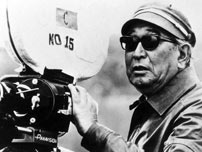
Akira Kurosawa. |
|
| |
Kurosawa’s The Seven Samurai is such a film, one that portrays the power of circumstance over its characters’ lives. The major “circumstance” in the film is this: with the invention of the gun and the development of the horse as an instrument of warfare, the samurai have been rendered obsolete as the warrior figures in Japanese society of the Sengoku period (1534-1615). Whereas it is samurai swordsmen who once would have raided a peasant village for rice and women, it is now gun-toting bandits on horseback who do so. This places the peasants in a unique position: they can hire the masterless samurai (ronin) to defend them for the price of three meals a day. But it also places the peasants in a precarious position: the samurai will teach them to do something they have never done before: defend themselves to the death (fig. 1).
“Circumstance” has forced a new role on them, for they are farmers by nature, fighters by chance (and necessity). “Circumstance” also forces dignified samurai to go about in shabby clothing and even to chop wood for a meal; it forces them to work for the very class of people, that is, for whom they once had the most contempt. “Circumstance” even gives the gun to anyone who can pay for it (unlike the sword, which takes a master to wield it, the gun can be mastered—especially at close range—by almost anyone), and thus turns the petty thief into the roving, deadly, greedy bandit, part of a larger robber band or “army.” “Circumstance” then dictates that three guns—all the bandits have—are not enough against the fighting expertise of the samurai combined with the sheer number of peasants. The day will come, of course, when all the bandits have guns, and that day will spell the end of the samurai and the rise of law enforcement, as well as the modern military, to protect the people.
Playing Out Destiny
The force of circumstance is clearly at work, then, throughout The Seven Samurai. But the film is hardly a treatise on man’s helplessness before circumstance, his dwarfing and destruction by it. The art of this film is in man’s playing out his destiny before circumstance, at the same time as circumstance seems to engulf him. The farmers fight and die for their freedom. The samurai defend the farmers no differently than they would defend themselves: nobly and fiercely. The bandits fight to the last man, against unbeatable odds in the end, apparently forgetting that their initial objective in storming the village was chiefly to seize the farmers’ crops: it is thus their own honor and fighting ability that have become the question. We see the ironies in the situation, but the farmers, the samurai, and the bandits do not, or they do only in passing. They act, and in action are exalted. |
|
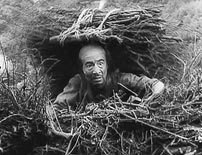
Fig. 1. The first shot of a peasant in the film shows him physically ”burdened”. |
|
| |
That, perhaps, is the sense in which this is truly an “action” or “epic” film: action does not occur for its own sake, or for the sake of mere spectacle; instead, it ennobles. The different protagonists act, no matter what they think or do not think. If they are aware of “circumstance,” they ignore or forget it, and, again, act. The concentration, in this way, is always on the human struggle more than on the existential dilemma. What matter are the present and the human more than the historical and the circumstantial. In this sense, the human transcends the circumstantial: those dead at the hands of circumstance are not mourned (farmers, samurai) or rejoiced over (bandits) at the finish of the film; the living go on living—the farmers plant rice, the surviving samurai move on, unhailed—the dead are dead, as indicated in the final shot of the burial mounds (Fig. 2).
Eastern Circumstance & Western Tragedy
The point must be made again, for the sake of contrast: The Seven Samurai is a film about circumstance, or about man and his relationship, at his best, to circumstance; it is not a film about fate or fatedness. In tragedy, man acts, often imprudently if inevitably, and then later reflects on his actions, wisely. In the work of circumstance, man simply acts wisely in the face of the impudence and unpredictability of circumstance. Tragedy focuses, in a way, unnaturally on man and his deeds. It presumes the authenticity and absolute rule of “fate,” and then sets man happily against it, or against himself (in whom fate may reside, as in the expression “character is destiny”). The work of circumstance focuses, more naturally, on the vagaries of circumstance and man’s often instinctive response to them. The foolishness or intemperance is in the universe; the caution and the wiseness (but not the hubris) are in man. Man thereby assumes a more modest position as a result and, in my estimation, comes off the better for it. For circumstance is the real enemy, the real force lurking at all times in the background of our lives.
“Fate,” by contrast, is the straw man in tragedy: one often senses that it has been created or invented merely for the display of man’s vanity, his self-obsession. “Fate” seems dominant in tragedy, but man outside fate is the real star as he demands, “Look at me!” “Fate,” one could say, is something man has invented to explain away his own obsessions and inadequacies. Circumstance, in contradistinction, is real or tangible, and man is most often defeated by it. At his best, he meets it (the adverse kind, that is) on equal ground, and if he does not triumph, he does not lose, either. Instead, he distinguishes himself in the fight. That is all, and that is enough. Of the three groups of characters in The Seven Samurai—the farmers, the samurai, and the bandits—this can be said with almost tactile sureness. |
|
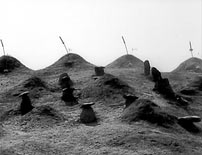
Fig. 2. The final shot of the burial mounds. There is one ceremonial burial, of the samurai Heihachi, earlier in the film, but, significantly, the human struggle interrupts it as the bandits appear en masse on the horizon. |
|
| |
To continue this line of thought, the work of circumstance is interested not only in what surrounds the human being, as Shinoda describes it, but also in how he reacts to those surroundings under duress. Tragedy is interested in what it thinks is immutable in each human being, and the world, and how this leads to man’s (noble) destruction. It is interested, in short, in man above all else, and in all his flaw (fig. 3). Circumstance places man more squarely in the world; “fate” pushes him back into himself. The one art looks out, the other in. The difference is between East and West, self and other. Appropriately, tragedy usually focuses on one main character; the work of circumstance, on several or many. Indeed, The Seven Samurai is not about the seven samurai themselves; it is about the characteristics of samurai—courage, honor, dignity—which circumstance conspires to bring out in people other than the samurai themselves. Remember, for example, that it is the farmers who first decide to fight the bandits, and only then do they think to hire samurai to help them.
Here is one salient example of the difference between Western tragedy and the Eastern “work of circumstance.” Near the end of the film, circumstance presents the young woman Shino (Keiko Tsushima) with a difficult choice. By now she is in love with the samurai initiate Katsushiro (Isao Kimura) and she must either go with him, a man of a higher class, or stay behind in her native village. She chooses to stay behind (fig. 4-5). Yet, even though she loves Katsushiro, Shino makes a wise choice. She will forget him in time—in fact, she seems to forget him immediately—and marry a man of her own class. She will suffer momentarily, but prosper in the long run. Shino suppresses self for “other,” in other words—for her relationship to her family, village, and the world she has known since birth.
What would have happened in a tragedy, given a similar situation? Shino and Katsushiro’s relationship would have been the basis for the entire film. Shino would have been irresistibly drawn to Katsushiro and would have planned to run off with him. Her parents would have disapproved of the relationship if they had known about it—but it is kept secret from them until the end. Shino’s love for Katsushiro would have been true, yet doomed by its own very intensity and the intensity of Katsushiro’s love as well, and the lovers’ consequent willingness to go to any lengths to marry. Shino and Katsushiro would both end up by committing suicide, and only in this way, in sorrow, would their families, separated by class, be joined.
We are, of course, in the world of Shakespeare’s Romeo and Juliet, where foolish (if sincere) and seemingly inexorable action on the part of the young protagonists leads to the wisdom of reconciliation between their long-feuding families. Romeo and Juliet choose self-fulfillment before duty to family and place, and they pay for it with their lives. To a Westerner, theirs is a noble sacrifice; to one such as Kurosawa, a senseless one—senseless, because it is the very intensity, if not compulsiveness, of Romeo’s love for Juliet that causes him to kill himself upon finding her “dead.” Even as Romeo was irresistibly drawn to Juliet, despite the serious feud between their otherwise socially equal families, so too is he rashly compelled to take his own life without investigating the circumstances of her “death.” Romeo does not thereby sacrifice himself for Juliet; he sacrifices himself to his own ideal of romantic love. His suicide, in other words, is paradoxically a form of self-endorsement: if he cannot have Juliet, then no one can have him. He places himself before the other members of his family and community, and it is this absorption with himself, this retreat into self, which drives him to commit suicide when he finds Juliet’s body. He is finally all alone, with no reference outside himself now that Juliet is “dead,” and therefore he fancies his own death as the only way to remain “alone” without suffering interminably. In sum, Romeo cannot think of anyone but himself, and that is what kills him, as he exhausts his powers of reason and measure. |
|
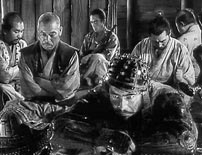
Fig. 3. Kikuchiyo (Toshirô Mifune) broods before condemning the flaws of peasants and samurai alike.
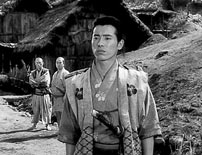
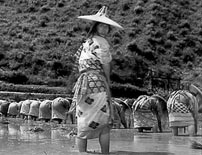
Fig. 4-5. Katsushiro comes to understand that Shino will stay behind. |
|
| |
Suicide: Duty or Accident?
Clearly, I am not trying to say that characters in Japanese films do not commit suicide or otherwise come to personal ruin. Think only of Shinoda’s own Double Suicide (1969) and his Ballad of Orin (1978). But there is a great deal of difference between lovers’ deliberately choosing suicide as a means of escape from society’s strictures (as in these two films)—killing themselves, in a sense, because they cannot fathom society’s harsh workings and simultaneously do not wish to rend its fabric—and Romeo’s killing himself (or, later, Juliet’s killing herself) in an hysterical moment of grief, because he thinks his Juliet dead (1).
Romeo’s and Juliet’s suicides, I mean to say, are accidents. They would never have happened but for the well-intentioned, if ultimately misguided, intervention of Friar Laurence in Juliet’s fate. Hers is a “tragic” accident in the sense it was inevitable that, in her all-consuming love, she would go to such extremes to be with Romeo, and in the sense that her family would not relent in its feud with the Montagues; but it is an accident nonetheless. Keep in mind that the reason for Juliet’s taking the potion in the first place was to appear dead to her family, so that she would be buried and later freed from her tomb by Friar Laurence, to run away with Romeo. She rejects her family and city and princedom, that is, for Romeo. |
|
(1) While the characters in a Western film such as Elvira Madigan (1967) do appear at first deliberately to choose suicide as a means of escaping ironbound social strictures, their deaths are so romanticized by director Bo Widerberg that this army officer and his mistress seem to kill themselves (tellingly, offscreen, as he shoots her and only then himself) for want of something better to do after idyllically sating their love, or out of selfish, self-indulgent fear that life outside the bounds of cozy bourgeois society will not be good enough for them. |
|
| |
Shakespeare, then, devotes a whole play to the actions of Romeo and Juliet. Kurosawa, for his part, makes the relationship of Shino and Katsushiro a small part of a work devoted to illustrating commitment to “other” before self, and to depicting sure and noble action in the face of unfavorable, even overwhelming, circumstance. Shino is one of many in The Seven Samurai who choose duty to “other” before self, and I think observers of the film have largely missed this aspect of it. Some of the samurai, for instance, at first resist the idea of joining up with Kambei (Takashi Shimura) to defend the village for two basic reasons: there is not enough monetary reward in it, and there is no honor in defending farmers. But they come around to his way of thinking, primarily because of their attraction to Kambei, their desire to ally with him, as samurai, and aid his cause (fig. 6). It is thus that the individual, vagrant samurai cohere into a single-minded fighting unit.
The young Katsushiro himself becomes Kambei’s disciple, against the latter’s wishes at first. Katsuhiro suppresses self, that is, for devotion to a master. And the few farmers outside the village proper initially want to save just themselves, not the village as a whole; but, after some coercion, they, too, forget about self and fight for “other.” The same goes for the bandits. Every one of them sacrifices self to “other,” as each bandit is killed in the battle with samurai and farmers. Not one bandit runs, for fear of death at the hands of his chief. (The chief says, pointing to a dead bandit, “Remember! Every coward here will get the same treatment.”) No one runs, despite one bandit’s prophetic remark, “The whole thing is back to front. Now we’re burnt out and hungrier than they are.” |
|
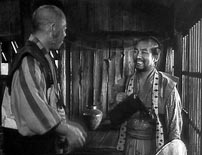
Fig. 6. Samurai Gorobei Katayama (Yoshio Inaba) takes on the job of defending the peasants because of Kambei. |
|
| |
Circumstance in this way unites man: the farmers with one another (fig. 7), just so the samurai (fig. 8), just so the bandits. It “unites” man further: circumstance turns farmer into near samurai in his courage and pride in fighting to the end; and it makes the samurai farmer-like in his desire to keep the rice crop from the bandits. (For it is this crop that the samurai, too, now shares, whereas once he had been bandit-like in its seizing.) Tragedy, by contrast, divides and isolates man. The knowledge that its protagonists derive from suffering is not common knowledge; it is knowledge that can only be had from profound suffering. So the message of tragedy is that man will suffer again, that the calm at the end of tragedy is therefore the calm before another storm. Man is steady and united in his facing circumstance: it draws him outside himself, and it gives him an experience common to many. Whereas he is unsettled and alone in the face of tragedy, or his own fate.
This is the message of tragedy, but beneath that message is buried a more important one, hinted at earlier in my essay: that it is precisely such excessive emphasis on the individual in the West which condemns man to further suffering. It is the total fascination and absorption with self, in other words, in art as in life, that leads to continued self-destruction. “Fate” in literature, drama, or film thus becomes almost beside the point. Individual deeds leading to isolation and suffering become almost beside the point. The point is that when man lacks a reference outside himself, when he is devoted to nothing except self-fulfillment and self-glorification or -aggrandizement, he will suffer, however grandly. He will break down. And he will meet his end.
From this point of view, then, tragic heroes in the West are condemned to defeat before they ever come to life on the page, the screen, or the stage. The very way of life, or worldview, that has produced them, in turn condemns them. This is not “fate” as applied to characters in works of art (as in, “It was Oedipus’s peculiar fate to be born to Jocasta and Laius, to whom it had been foretold that their son would kill his father and marry his mother”). It is life as applied to Western man generally.
Kurosawa Lives
But it is not life as seen by an Eastern man like Akira Kurosawa, who, in 1961, at the height of the Cold War and subsequent to the detonation of the first hydrogen bomb in 1956, could unfatalistically declare that his aim as a filmmaker was “to give people strength to live and face life; to help them live more powerfully and happily.” (The threat of all-out atomic warfare forms the subject of Kurosawa’s Record of a Living Being, which is a literal, “circumstantial” rendition of the Japanese title, whereas the fateful title of the film upon its release in the United States and England was I Live in Fear.) Around twenty years later, at the time of Kagemusha, he still had not capitulated to fate, even though he did say, “I think it’s impossible in this day and age to be optimistic.” Nonetheless seeing possibilities in the medium of film, Kurosawa maintained that he “would like to be able to create hope somewhere, under certain circumstances.” He did, he does. |
|
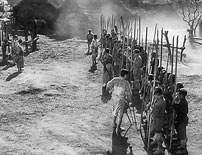
Fig. 7. The peasants line up.

Fig. 8. In a striking shot towards the end of the film the four dead and the three living samurai come to share the same frame one final time. |
|
 |
 |
 |
 |
 |
|
 |
 |
 |
| |
Facts
Bibliography
Cardullo, Bert. “‘I Am Simply a Maker of Films’: A Visit with the Sensei of the Cinema (1992).” In Akira Kurosawa: Interviews. Ed. Bert Cardullo. Jackson: University Press of Mississippi, forthcoming in 2008.
Kurosawa, Akira. Something Like an Autobiography. New York: Alfred Knopf, 1982.
Mellen, Joan. “Interview with Akira Kurosawa.” In Mellen’s Voices From the Japanese Cinema (New York: Liveright, 1975), pp. 43-58.
Mellen, Joan; Mellen, Josn. The Waves at Genji's Door: Japan through Its Cinema. New York: Pantheon, 1976.
Richie, Donald. Kurosawa Interview. Sight and Sound, 33, #3 (Summer 1964), pp. 108-113; 33, #4 (Autumn 1964), pp. 200-203.
Shirai, Yoshio; Shibata, Hayao; Yamada, Koichi. “’L’Empereur’: entretien avec Kurosawa Akira.” Cahiers du cinéma no. 182 (September 1966), pp. 34-42.
Yakir, Dan. “The Warrior Returns: Akira Kurosawa Interviewed.” Film Comment 16, 6 (Nov.-Dec. 1980), pp. 54-57. |
|
|
|
|
 |
 |
 |
 |
16:9 - september 2007 - 5. årgang - nummer 23
Udgives med støtte fra Det Danske Filminstitut samt Kulturministeriets bevilling til almenkulturelle tidsskrifter.
ISSN: 1603-5194. Copyright © 2002-07. Alle rettigheder reserveret. |
11 |
|
|
 |
 |
|
|